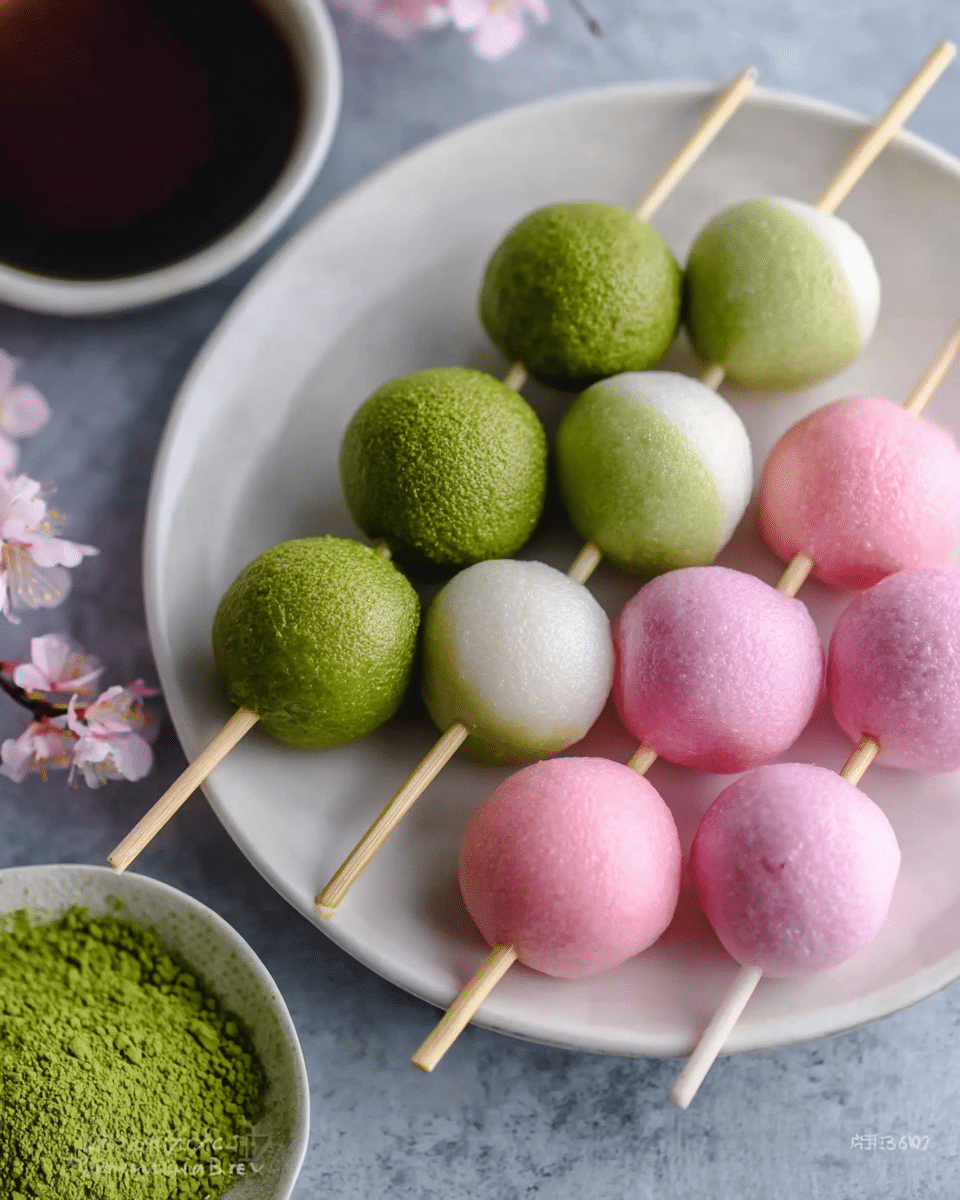The Significance of Hanami Dango in Japanese Culture
In Japan, Hanami Dango is traditionally associated with Hanami, a custom that involves appreciating the beauty of cherry blossoms. During the spring, families and friends gather under blooming cherry trees to enjoy picnics, and Hanami Dango is a popular food item during these celebrations. The colors of the dango are symbolic: the white color represents purity and the snow that remains during early spring, the pink represents the cherry blossoms themselves, and the green symbolizes the new growth of the season. Eating these colorful rice balls while surrounded by the beauty of nature adds to the celebratory and symbolic nature of Hanami.
Beyond the spring festival, Hanami Dango also makes appearances at other cultural and seasonal events in Japan. Its versatility as a snack, as well as its stunning appearance, has made it a beloved treat not just in Japan but around the world. Making Hanami Dango at home allows you to connect with a cultural tradition and brings a piece of Japanese spring celebrations into your own kitchen.
The Key Ingredients for Hanami Dango
The beauty of Hanami Dango lies in its simplicity. The dough for the rice balls is made with two types of rice flour: Joshinko (non-glutinous rice flour) and Shiratamako (glutinous rice flour). These flours are the foundation of the dango, providing the right texture. The glutinous rice flour gives the dango its signature chewy consistency, while the non-glutinous rice flour contributes to its overall structure and texture.
The addition of powdered sugar is optional and used for sweetness, balancing out the neutral flavor of the rice flour. While the dough itself is relatively plain, it is this simplicity that allows the natural sweetness and texture to shine. For color, pink food coloring and matcha powder are added to portions of the dough, giving the dango its vibrant hues. These additions are not just for appearance—they also lend a delicate flavor to the rice balls. The pink color, often achieved with food coloring, adds a hint of sweetness, while matcha powder gives the dango a mild, earthy flavor that complements the subtle sweetness of the rice flour.
The cooking process, which involves boiling the rice dumplings and cooling them in ice water, is essential to achieving the right texture: chewy on the outside, soft on the inside. Once prepared, these colorful rice balls are traditionally skewered and served as part of springtime celebrations.
Making the Dango: The Process and Techniques
Creating Hanami Dango is a relatively straightforward process, but the key to perfecting the texture and flavor lies in the precise handling of the dough and cooking technique. The first step is to combine the Joshinko and Shiratamako rice flours, which form the base of the dough. Adding hot water gradually while stirring ensures that the flour mixture comes together without becoming lumpy. Once the dough is smooth, it is divided into three portions, each of which is flavored with either matcha powder, pink food coloring, or left plain.
One of the most important steps is kneading the dough. It’s crucial to knead the dough until it’s smooth and pliable. The dough should not be too sticky or too dry; the right consistency will allow you to shape the dough into balls easily. The goal is to create soft, smooth rice balls that are neither too tough nor too fragile. Once the dough is properly kneaded and divided, the rice balls are rolled into small portions, typically about 20 grams each. These rice balls are then boiled until they float to the surface of the water, indicating that they are cooked through.
After boiling, the rice balls are cooled in ice water to stop the cooking process and maintain their chewy texture. This step is important, as it gives the dango the perfect balance of firmness and tenderness. The cooled dango balls are then skewered onto bamboo sticks, usually in a specific order—green, white, and pink—creating the beautiful, traditional appearance of Hanami Dango.
Serving Suggestions: A Beautifully Versatile Dessert
Hanami Dango is traditionally enjoyed with sweet toppings that enhance its flavor. The most common topping is a drizzle of sweet soy glaze, which adds a sweet, savory contrast to the neutral flavor of the rice balls. This glaze, made from soy sauce, sugar, and sometimes mirin, provides an extra layer of richness that pairs perfectly with the chewy texture of the dango. Another popular topping is red bean paste, which adds a subtle sweetness and depth of flavor to the dango. The slightly earthy flavor of the red bean paste complements the mild sweetness of the dango, making for a well-rounded dessert.
In addition to these traditional toppings, you can also experiment with other flavor pairings. Matcha paste, made from finely ground green tea powder and sugar, is a great option for those who love the earthy, slightly bitter flavor of matcha. A dusting of roasted soybean flour (kinako) also makes for a delicious topping, adding a nutty flavor that pairs wonderfully with the chewy texture of the dango.
Hanami Dango can also be served on its own as a light snack or dessert. The rice balls are delightful when served chilled, making them a refreshing treat for warm weather. Whether enjoyed as part of a spring picnic or served as a snack during a tea ceremony, Hanami Dango is versatile enough to suit a wide variety of occasions.
The Cultural Significance of Hanami Dango
Making and eating Hanami Dango is more than just preparing a tasty dessert—it’s a cultural tradition that connects people to the spirit of Japanese springtime. The act of gathering to enjoy dango under the cherry blossoms during the Hanami festival is a deeply rooted custom that celebrates the fleeting beauty of the cherry blossoms and the changing seasons. Hanami Dango, with its vibrant colors and symbolic meaning, is a representation of the joy and appreciation that comes with nature’s cycles.
As a symbol of spring, Hanami Dango invites people to slow down and savor the beauty of the world around them. Sharing this treat with friends and family during cherry blossom season is an opportunity to create memories and deepen connections, all while enjoying the sweetness of life.
Customizations and Variations
While the traditional Hanami Dango recipe features a combination of white, pink, and green rice balls, there are plenty of ways to customize this dessert to suit personal preferences. For example, instead of using food coloring, you can experiment with natural ingredients to create different colors. Hibiscus petals, for instance, can be used to achieve a natural pink color, while spinach or kale can be blended to create a green dough.
In terms of flavor, you can add other ingredients to the dough to create unique variations. For instance, adding coconut flakes to the dough gives the dango a tropical flavor, while substituting a portion of the rice flour with sweet potato flour or matcha powder offers a distinct twist on the traditional recipe.
Conclusion
Hanami Dango is a beautiful and delicious Japanese dessert that captures the essence of spring in both flavor and symbolism. With its chewy texture, vibrant colors, and rich flavor profile, it’s a treat that delights the senses and connects people to the cultural traditions of Japan. Whether enjoyed as part of the cherry blossom festivities or as a sweet snack on a regular day, Hanami Dango brings joy to every occasion. The simplicity of the ingredients and the ease of preparation make it an accessible dish for home cooks, while the versatility in flavor and presentation ensures that this treat can be enjoyed by all. From its traditional flavors to modern twists, Hanami Dango offers something for everyone, making it a must-try recipe for those looking to experience the beauty of Japanese desserts.






